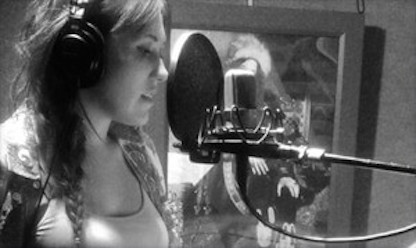Voice over demo: what makes a great demo?
A guide to do it right

How do you achieve the Holy Grail of voice over?
Now, let's develop a little. To do this, put yourself in the shoes of a client looking, for instance, for THE French voice actor for his project. You have twelve voice over demos to listen to. Twelve demos that correspond pretty closely to the type of voice you're looking for. So what do you do? Make an initial selection. How do you do that? By listening to the first five seconds of each demo. Yes, no, maybe, definitely no, yes, no, maybe, no, no, no, never, yes... Cruel, but true.
That's seven demos in the bin, so that leaves five to go. So what do we do now? Well, like in the elections, we'll have a second round. This time, we'll listen for three seconds every seven seconds. And there's another two in the bin.
For the third round, we listen to each demo, all the way through, or even two or three times each. And there you have it, a winner on top of the podium, shaking a magnum of champagne... well, almost.
It's easy to see why, given that casters don't have much time, the first few seconds are crucial to making an impression. But what else?
Your demo is about... you
Firstly, there are certain tell-tale signs. For example, the length of the demo. A professional medley demo lasts between sixty and ninety seconds maximum. When a voice over casting director sees a demo that lasts five minutes, it's a sign that the person presenting the demo hasn't mastered the codes of the sector and is therefore an amateur. Rubbish.
Secondly, the content of the demo. A demo that includes an entire advert, with several voices, then a poem, followed by a dentist on-hold message and a hysterical cartoon character, is indicative of someone who doesn't understand what's expected of them. Different types of work require different types of demo. An advertising demo, a corporate demo, a character demo, a promo demo, an e-learning demo, a narration demo... Why? Because someone casting for a TV commercial, for example, wants to hear - ONLY - what's relevant to his casting, which saves him precious time. Anything else? Yes, in the bin.
Let's move on to what your voice over demos should be. They're your shop window, your brochure, your CV: they should be a faithful representation of your talent. YOUR talent, not that of the DA who directed you, not that of the sound engineer who edited it... You. Either you've got several years' work behind you and your demos will be montages of different recordings you've made, or you're just starting out and you'll have recorded demos. It doesn't matter. Just make sure that what you're singing is right for your voice. If you're a woman with a very young voice, don't play a 45-year-old executive. If you have a voice like mine, don't pretend to be a teenager. Don't pretend. And why not? Because it's rubbish.
Chameleons live in the desert, not in the studio
Claiming that you can do anything to get every job is rarely a winning strategy. In fact, it almost never is. Leave the concept of the chameleon voice to the very few actors who have made it their speciality and to the many more who mistakenly think they belong to the Chamaeleonidae family. I develop this subject in 
In the overwhelming majority of cases, nobody wants a chameleon: if I'm looking for a friendly, natural, gentle, reassuring and professional 35-year-old osteopath mum, I want to hear a talent present different facets of her voice, how she approaches the script, her interpretations... not a chameleon.
I couldn't care less whether this voice over talent is good at doing a toothless great-grandmother, an overexcited prepubescent teenager or the sound of a TGV train in the middle of the countryside on a rainy Sunday in November. Unless, of course, I'm looking for all four at once, which I'm sure you'll agree is a statistical near impossibility. If you really can do it, these vocal prowesses belong in the character demo, not the commercial demo. Or join a circus, you'll make a fortune.
Demo? No, Demos
If you take just one thing away from this article: one demo per genre. No mixing. Well, try to remember more than one thing, or bookmark this page! Seriously, your French commercial voice over demo medley should ONLY contain TV and web spots. If you've already got a few campaigns under your belt, it should start with the biggest ad you've recorded: a well-known brand gives casters confidence. Not the whole ad: just the most representative part, with the brand. You can also make a visual demo, which has much more impact on social media than just posting a link to your mp3 demo - example with my visual English with French accent commercial showreel.
By the way, NEVER use a voice other than your own. It's confusing.
For number two, put something that best represents your voice and offers a different interpretation from the first extract. You want to present your trademark, but also your range. Mind you, this doesn't mean: first, the voice of a tattooed gruff roughty toughty, followed by Caliméro. It simply means offering a variation that allows your client to hear your versatility, and that you can adapt your interpretation to what is required. For example, you can go from a warm script to a more informal reading, then to a more informative tone. Without losing your identity. Consistency is the keyword here.
Your e-learning voice over demo: it should contain extracts that demonstrate your ability to narrate technical, difficult and sometimes - let's face it! - boring subjects, and to tell them in a way that keeps the audience interested. This demo should contain at least a few 'dry' extracts, i.e. without music or effects - just your voice. This allows the casters to hear your phonogeny which, for a corporate video for example, is extremely important as it 'colours' the video, the soundtrack (music and effects, also known as M&Es in English) often being no more than a carpet.
Why isn't this recommended for the commercial voice over demo? Good question. Answer: because in advertising, the voice is just one of the sound elements used to dress up a spot, and it's important to demonstrate your ability to work in harmony with the sound (rhythm, silences, projection, intention, feelings), rather than in opposition or in a power struggle (more on this subject in my article A Question of Organs).

The narration demo: include interpretations of documentaries, selected texts and an extract from a book (a short paragraph, not the whole book!) if you want to try your hand at audiobooks. Here again, it's extremely difficult to master this particular art, and should only be recommended to voice actors who are very experienced in this exercise. I talk about audio book narration in my article Audiobooks: Let's Talk About It.
Do you sing? Do you sing well? And by "well" I mean at a professional level? Do a jingle demo - but above all, no jingles in your commercial demo.
Homemade?
If you have years of experience, know your market inside out and have the necessary technical skills, why not? If not, don't even think about it. Remember, you've got one chance and one chance only - don't blow it by presenting amateur work when applying as a professional. Investing in the best demo possible is absolutely essential to your success. Investing, a dirty word for some who don't understand the difference from spending, a touchy topic I discuss in the article Voice Over: Investing in Your Business.
And finally, technique: don't skip this paragraph!

Make sure your voice over demos are in mp3 format, 128kbps mono. It's not the best quality, of course, but a demo is just a demo, not an opera - and it reduces the size of the file, making it easier to send by email.
If you send a 74Mb wav you know where it's going to end up.
Thank you for reading this article and if you found it interesting, think of your colleagues and share it on your social media! I invite you to share your experience here and leave your comments, suggestions or questions. I'll do my best to answer them.
PS: by subscribing to this voice over blog, you will have exclusive access to new articles before they are officially published. It's free so make the most of it, subscribe now !





Good evening Pierre,
First of all THANK YOU for this very informative article, which won't end up in the bin. I'm an actress fresh out of school and I was wondering how I could record my demo tape more cheaply. I'd love to work in voice-over and dubbing, but I don't yet have the means to record in a studio. I've realised that home-made demo tapes are out of the question. What advice would you give me on how to create a high-quality voice-over demo at a lower cost?
Thank you in advance for your help!
Alexandra
Hi Alexandra, it's a pleasure! Unfortunately, there's no shortcut. A professional demo with impeccable sound is a must!
Hello Pierre,
Thank you very much for this very comprehensive article! It's a great help in preparing a demo that's guaranteed not to be self-gripping (or self-sabotaging, as you prefer)... I hope!
Good luck and see you soon,
Fanny
It's a pleasure, Fanny, and please feel free to share it with your network!
Thank you Pierre for your valuable advice.
Do you think that recording extracts (in professional quality I'm sure) (advertising, ealerning, datamotion, documentary...) that you haven't produced yourself, but of course specifying it well, is a hindrance? You have to start well and in training you often only leave with 3-4 demos.
With pleasure Gweltaz - no, not at all, once again the ears make the cast, but be careful: you only get one chance to make a good first impression.